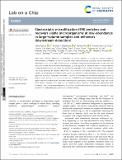Electrostatic microfiltration (EM) enriches and recovers viable microorganisms at low-abundance in large-volume samples and enhances downstream detection
Author(s)
Liu, Yaoping; Raymond, Joshua J; Wu, Xiaolin; Chua, Patrina Wei Lin; Ling, Sharon Yan Han; Chan, Chia Ching; Chan, Cheryl; Loh, Joanne Xin Yi; Song, Melody Xing Yen; Ong, Matilda Yu Yan; Ho, Peiying; Mcbee, Megan E; Springs, Stacy L; Yu, Hanry; Han, Jongyoon; ... Show more Show less
DownloadPublished version (3.076Mb)
Publisher with Creative Commons License
Publisher with Creative Commons License
Creative Commons Attribution
Terms of use
Metadata
Show full item recordAbstract
Rapid and sensitive detection of pathogens in various samples is crucial for disease diagnosis, environmental surveillance, as well as food and water safety monitoring. However, the low abundance of pathogens (<10 CFU) in large volume (1 mL−1 L) samples containing vast backgrounds critically limits the sensitivity of even the most advanced techniques, such as digital PCR. Therefore, there is a critical need for sample preparation that can enrich low-abundance pathogens from complex and large-volume samples. This study develops an efficient electrostatic microfiltration (EM)-based sample preparation technique capable of processing ultra-large-volume (≥500 mL) samples at high throughput (≥10 mL min−1). This approach achieves a significant enrichment (>8000×) of extremely-low-abundance pathogens (down to level of 0.02 CFU mL−1, i.e., 10 CFU in 500 mL). Furthermore, EM-enabled sample preparation facilitates digital amplification techniques sensitively detecting broad pathogens, including bacteria, fungi, and viruses from various samples, in a rapid (≤3 h) sample-to-result workflow. Notably, the operational ease, portability, and compatibility/integrability with various downstream detection platforms highlight its great potential for widespread applications across diverse settings.
Date issued
2024-09-10Department
Singapore-MIT Alliance in Research and Technology (SMART); Massachusetts Institute of Technology. Center for Biomedical Innovation; Massachusetts Institute of Technology. Department of Electrical Engineering and Computer Science; Massachusetts Institute of Technology. Department of Biological EngineeringJournal
Lab on a Chip
Publisher
Royal Society of Chemistry
Citation
Liu, Yaoping, Raymond, Joshua J, Wu, Xiaolin, Chua, Patrina Wei Lin, Ling, Sharon Yan Han et al. 2024. "Electrostatic microfiltration (EM) enriches and recovers viable microorganisms at low-abundance in large-volume samples and enhances downstream detection." Lab on a Chip, 24 (18).
Version: Final published version